I’ve been looking through my published blog posts for some that might be worthy of repeating. This article from 2020 is one that I thought folks might find helpful. The screenshots may not exactly match how things look currently on Newspapers.com and to be honest I haven’t had a subscription in awhile so I wasn’t able to verify that all the steps are exactly right. But I’m going on faith that it’s up-to-date enough to be helpful to those looking for ideas on including newspaper articles in their genealogy database. When I published it originally, it garnered some valuable comments, so you might want to check the comments on the original version.
 I’ve been doing a lot of research on Newspapers.com recently. I downloaded a number of articles about my maternal grandparents, Crawford and Susie (Jeffries) Brown, who lived in Spokane, Washington, from 1936 until their deaths in the 1990s. My mother, Betty Sue Brown Adams, was born in Missouri in 1933, but the family to Spokane when she was three and lived there until she left for college.
I’ve been doing a lot of research on Newspapers.com recently. I downloaded a number of articles about my maternal grandparents, Crawford and Susie (Jeffries) Brown, who lived in Spokane, Washington, from 1936 until their deaths in the 1990s. My mother, Betty Sue Brown Adams, was born in Missouri in 1933, but the family to Spokane when she was three and lived there until she left for college.
The Spokesman-Review, Spokane’s daily paper, is part of Newspapers.com Publisher Extra collection. I did a seven-day free trial with them and when it was over I still I had research I wanted to do, so I signed up for a 30-day subscription for $19.99. (I didn’t want to spend $60 for a six-month subscription.) With the clock ticking, I’ve been downloading articles and also working through my backlog of downloaded articles. In doing so much research on Newspapers.com, I’ve developed a method of downloading and processing the articles that I thought I’d share with you here with some screenshots in case it’s helpful.
As always, I’m sharing what works for me…that doesn’t make it the right way or the best way. And it doesn’t mean I won’t change it up later. But this is what I’m doing now. (Several years ago, I did a screencast of how I process newspaper articles from Genealogy Bank, which was slightly different. If you’re interested, you can check it out here.)
When you find an article on Newspapers.com, you have the option to clip the article so that you find it later on Newspapers.com and others can see it (you can also download, share or save on Ancestry.com by clipping an article), or you can print or save the article. Because I don’t plan to keep my Publisher’s Extra subscription and because I prefer to download everything to my hard drive, I choose to the download the article and also to download the entire page it is on, for context. Here’s what I do:
Once I’ve found an article that I want to save (in this example, it’s a 1943 article about my ten-year-old mother performing in a musical program at a PTA meeting), I click on Print/Save.
Then I click on Select portion of page. (Click on any of these images to make them larger.)
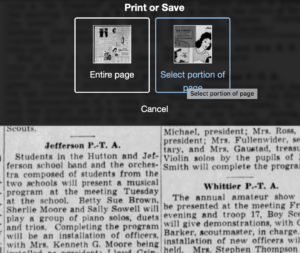 Then I outline the article using Newspaper.com’s grab tool and click Save.
Then I outline the article using Newspaper.com’s grab tool and click Save.
Once I click Save, I’m given an option of saving it as a jpg or a pdf. When you save as a pdf, the source information is included. I always save a clip as a pdf.
Once I click Save as PDF, the article is downloaded to my hard drive. When I open it, it looks like this:
You can see that Newspapers.com has included the newspaper title, date, and page number of the article, as well as the date it was downloaded and the URL for the image. This is really helpful when I create the source citation in Reunion, the genealogy software I use on my Mac. Notice that I have changed the filename of the article per my file-naming protocol. I always put “clip” in the filename for the clipped articles, since I will also download the entire page using the same filename (minus “clip”). I save the article in my Surnames folder.
Next, I go back to newspapers.com, click on Print/Save again, and this time select Entire Page. Then I’m asked if I want to save it as a jpg or pdf. I always save the whole page, as a jpg. That’s just my personal preference.
 Once I click Save as JPG, the page is downloaded and I change the filename to match the clip’s filename (omitting the word “clip.”)
Once I click Save as JPG, the page is downloaded and I change the filename to match the clip’s filename (omitting the word “clip.”)
Now it’s time to glean information from the article and add it to Reunion.
I take a fact from the article, enter it into Reunion and create a source citation. In Reunion, I use the template for Newspapers to create my source citations. So here’s what the source record for this article looks like (again, click any image for a larger view):
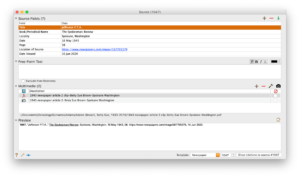 Note that I have attached both files, the clip and the whole page, as multimedia files in the source citation, by simply dragging them from the Finder. But before I do that, I do one other thing. I click on the little clipboard icon in the Preview pane and I paste the citation into the metadata of the file. Here’s how I do that.
Note that I have attached both files, the clip and the whole page, as multimedia files in the source citation, by simply dragging them from the Finder. But before I do that, I do one other thing. I click on the little clipboard icon in the Preview pane and I paste the citation into the metadata of the file. Here’s how I do that.
I highlight the two files (article and whole page) in Finder, right (or control) click on them and then select Get Info. That brings up the metadata for those files. I paste the source citation in the Comments field. This is really helpful later on if I want to see which source a particular file is attached to.
Then I drag the files into the source record. After I’ve gleaned all the information from the articles, I file them in my folder structure.
A final note: In this particular example, you might be curious how I entered this tidbit about a musical program in Reunion. Under Residence in the Events tab, I added the date of the newspaper article and Spokane, recording that my mother lived in Spokane on 16 May 1943. But I took it a little further. This was one of six Spokesman-Review articles I found about my mother performing as a girl. So in the Notes tab I also created a little listing of those performances. Here’s a screenshot:
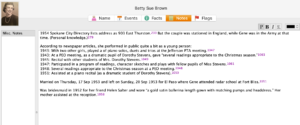 I don’t know if it looks complicated laid out like this, but it really isn’t. I pretty easily got into the rhythm of it. The process can get a little tedious, but I think it’s worth the effort to have both the clip and the whole page downloaded. The little nuggets you get from newspaper research can really paint a great picture!
I don’t know if it looks complicated laid out like this, but it really isn’t. I pretty easily got into the rhythm of it. The process can get a little tedious, but I think it’s worth the effort to have both the clip and the whole page downloaded. The little nuggets you get from newspaper research can really paint a great picture!
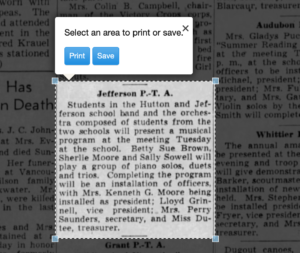
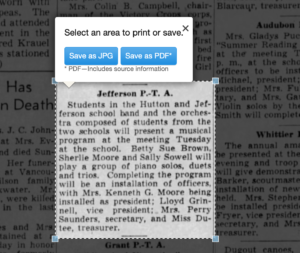
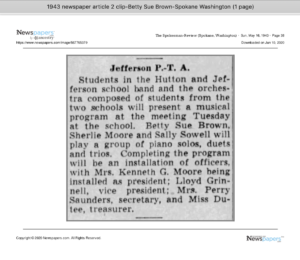
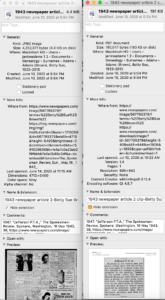

I use a spreadsheet for my newspaper articles. I have one for each family and start with the year which gives me a family timeline. I also list where I got the article from like newspapers.com , list the person and a short description of the article. Like band performance or birthday party. That way all my newspaper articles are in one place no matter where I get them.
Thank you for sharing your method, Trisha!
This is very helpful Janine and timely since I’ve just renewed my Newspaper.com subscription.
I do have a couple of questions about your process – 1)if you have done a clip of the article and have the full source citation what is the purpose of downloading the full page? 2) I’ve found that if I add a media file to Reunion and the move the location of that file, it shows up as an error (file not found) in Reunion. Your process indicates that you only add your file to your folder structure after you’ve uploaded it to the source so I’m wondering how you avoid the problem I encountered?
I like to download the full page so that I have it in case I want to scour it for context. And since I might not always have a newspapers.com subscription it seems prudent to download while I have it.
I don’t have the problem with Reunion that you’re describing. I just tried it on a downloaded but not-yet-processed pair of newspaper articles and I was able to open the files from the Reunion source citation even though I filed them in the ancestor folder after creating the citation and adding the media files. When I tried immediately after filing those files, nothing happened when I clicked on the files (not even an error message). So I closed Reunion and then reopened it and I could see those files. I don’t know why our outcomes are different. I’m using Reunion 13.
It’s been a while since I had the problem with the media files so I wonder if that was a bug that has now been fixed. I’m using Reunion 14
I hope that’s the case!
Thanks for re-introducing this topic, Janine. This is a fairly Mac- and Reunion-centric response, but I think Windows users can use parallel applications (like Snipping Tool) on their systems to achieve the same things. I apologize for the length, but I guess my heavy usage of Newspapers.com has given me OPINIONS.
Newspapers.com has helped me over some steep brick walls, and saving the clipping is “vital” when that happens, because the clipping becomes a substitute for a vital record. In addition to citing it in my Reunion source, I like to post it on my Ancestry tree and sometimes FindaGrave. For that, I think it’s important to keep a visible label in the image, showing the newspaper name, date, and page, to “ride along” when downloaded. For Findagrave, it needs to be a JPG, and I also prefer to use a JPG on Ancestry, because in the Gallery its thumbnail looks like a newspaper clipping, while a PDF’s thumbnail is a dark square.
To get a small clipping, sometimes I use Screenshot and include Newspapers.com’s info about the newspapers in the “shot.”
If it’s a longer story, I use the Clip button in Newspapers.com, making it the “clip” bigger than the story itself. Then I use Preview’s Annotate feature to add that label in the extra space.
Have you noticed that Newspapers.com will give you a (usually buggy but useful) transcript of the story if you use its Clip feature? To get it, click on the Save button and then the View Clip button. On the page that it then brings up, scroll down to the bottom, and it will display the OCR of the text. It usually needs some doctoring to get the text right, but I copy and paste it into the Free-Form Text field of my Reunion source definition. I figure that having, say, the pastor’s name in a text-searchable article about a wedding might someday help me search out and understand a connection that I wouldn’t find with just the image of the story.
Do you ever resort to opening the Sources window in Reunion and searching for some familiar name who hasn’t been defined as a Person yet? Or place?
Marian,
I always appreciate the time you put in to create a really helpful comment. Thank you!
You make such a good point about the jpg being a useful format for the clipping itself so that it’s sharable on FindAGrave and more useful on Ancestry. Thank you.
I was not aware of the transcript that Newspapers.com now provides. That’s terrific, and what a great idea to paste it into the Free-Form Text field for searchability within your Reunion database.